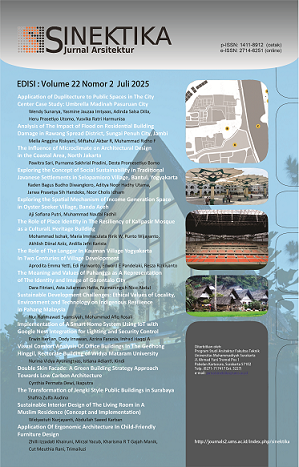Exploring The Spatial Mechanism of Income Generation Space in Oyster Seeker Village, Banda Aceh
DOI:
https://doi.org/10.23917/sinektika.v22i2.7087Keywords:
Alue Naga, Design-Driven Research, Income Generation Space, Oyster Seeker, Spatial MechanismAbstract
The oyster seeker community in Alue Naga relies on the coastal environment for finding, cultivating, harvesting, processing, and selling oysters. The spatial dynamics of interaction among humans, oysters, and the coastal environment that generates income for the oyster-seeking community remains thoroughly underexplored. This study investigates the spatial mechanisms of income-generating spaces created by oyster seeker activities in Alue Naga, Banda Aceh, Indonesia. The research aims to explore the spatial patterns formed by the activities and practices of oyster seekers that contribute to their daily income. This study employs a design-driven research method, utilising a qualitative approach shaped by design thinking, spatial sensitivity, and a thorough architectural understanding using meaning from interviews and on-site observations. The research indicates that income-generating activities in Alue Naga oyster seeker village are established through three different spatial mechanisms: 1) the utilisation of land and water border areas, 2) the use of time and domestic space as components in the income-generating process, and 3) social aspects as the engine of spatial mechanism to generate income. This research also reveals that coastal environments can generate spatial mechanisms that shape income-generating spaces for coastal communities, which should be considered when designing spaces, architecture, and urban contexts.
Downloads
References
Atmodiwirjo, P., AndriYatmo, Y., & Ujung, V. A. (2015). Outside interior: Traversed boundaries in a Jakarta urban neighbourhood. Idea Journal, 15(1), 78–101.
Attiwill, S. (2011). Urban interior: Interior-making in the urban environment. Proceedings of the 2011 IDA Congress Taipei Education Conference, 217–224.
Blessing, L. T., & Chakrabarti, A. (2009). DRM: A design research methodology. Springer.
Borrego, I., Pasel, R., & Weidinger, J. (2023). CA^2RE+ 3–Frameworks of Design-Driven Research (Vol. 3). Berlin Universities Publishing.
Chen, M. A., & Sinha, S. (2016). Home-based workers and cities. Environment and Urbanization, 28(2), 343–358. https://doi.org/10.1177/0956247816649865
Dovey, K. (2016). Urban design thinking: A conceptual toolkit. Bloomsbury Academic, An imprint of Bloomsbury Publishing Plc.
Dovey, K., Shafique, T., Van Oostrum, M., & Chatterjee, I. (2021). Informal settlement is not a euphemism for ‘slum’: What’s at stake beyond the language? International Development Planning Review, 43(2), 139–150. https://doi.org/10.3828/idpr.2020.14
Dovey, K., Van Oostrum, M., Chatterjee, I., & Shafique, T. (2020). Towards a morphogenesis of informal settlements. Habitat International, 104, 102240. https://doi.org/10.1016/j.habitatint.2020.102240
Fadhil, M. N., & Putri, A. S. (2024). Framing Architectural Identity of Aceh After Two Contemporary Events. Arsitektura: Jurnal Ilmiah Arsitektur Dan Lingkungan Binaan, 22(2), 263–274.
Groat, L., & Wang, D. (2013). Architectural research methods (2. ed. [updated and expanded]). Wiley.
Grobler, A., & Le Roux, S. (2006). Criteria for spatial definition: Architectural and urban interiors of the Constitutional Court, Johannesburg. South African Journal of Art History, 21(1), 47–69.
Harani, A. R., Atmodiwirjo, P., & Yatmo, Y. A. (2021). Interiorization: Spatial mechanism to generate interior condition in an urban kampung neighborhood. Alam Cipta, 14(2), 1–9.
Kamalipour, H. (2016). Forms of informality and adaptations in informal settlements. International Journal of Architectural Research (ArchNet-IJAR), 10(3), 60–75.
Kellett, P., & Tipple, A. (2003). Exploring Space: Researching the use of domestic space for income generation in developing cities. IAPS/ENHR International Conference: Methodologies in Housing Research.
Kellett, P., & Tipple, A. G. (2000). The home as workplace: A study of income-generating activities within the domestic setting. Environment and Urbanization, 12(1), 203–214.
McFarland, K., Vignier, J., Standen, E., & Volety, A. (2022). Synergistic effects of salinity and temperature on the eastern oyster Crassostrea virginica throughout the lifespan. Marine Ecology Progress Series, 700, 111–124. https://doi.org/10.3354/meps14178
mcny.org. (2024). Future City Lab: Oysters and their Habitat. The Museum City of New York. https://www.mcny.org/education
Merriam-Webster, M.-W. (2002). Merriam-webster. In On-line at http://www. Mw. Com/home. Htm (Vol. 8, p. 23).
Putri, A. S., & Fadhil, M. N. (2023). Citra Perdagangan Informal di Simpang Tujuh Ulee Kareng Banda Aceh. Jurnal Arsitektur TERRACOTTA, 4(3), 213.
Shah, S. J., & Muro, C. (2023). Manifestations of Urban Interiority in Delhi Gate Bazaar of Lahore. Interiority, 6(2). https://doi.org/10.7454/in.v6i2.318
SIGAP, S. I. G. (2024). Sejarah Alue Naga. Alue Naga. Sistem Informasi Gampong. https://aluenaga.sigapaceh.id/dashboard/sejarah/
Suhartini, N., & Jones, P. (2023). Beyond the Informal: Understanding Self-Organized Kampungs in Indonesia. Springer International Publishing. https://doi.org/10.1007/978-3-031-22239-9
Sunarti, S., Syahbana, J. A., & Manaf, A. (2019). Space transformation in a low-income housing community in Danukusuman, Surakarta. International Journal of Housing Markets and Analysis, 12(2), 265–280.
Thai, H. M. H., Stevens, Q., & Rogers, J. (2019). The influence of organic urban morphologies on opportunities for home-based businesses within inner-city districts in Hanoi, Vietnam. Journal of Urban Design, 24(6), 926–946. https://doi.org/10.1080/13574809.2018.1554995
Tipple, G. (2005). The place of home-based enterprises in the informal sector: Evidence from Cochabamba, New Delhi, Surabaya and Pretoria. Urban Studies, 42(4), 611–632.
Verrest, H., & Post, J. (2007). Home-based economic activities, livelihoods and space in Paramaribo, Suriname. International Development Planning Review, 29(2), 161–184.
Yatmo, Y. A., & Atmodiwirjo, P. (2013). Spatial strategies for domestic service activities in urban kampung houses. International Journal of Technology, 4(1), 24–33.
Downloads
Submitted
Accepted
Published
Issue
Section
License
Copyright (c) 2025 Sinektika: Jurnal Arsitektur

This work is licensed under a Creative Commons Attribution-NonCommercial 4.0 International License.











